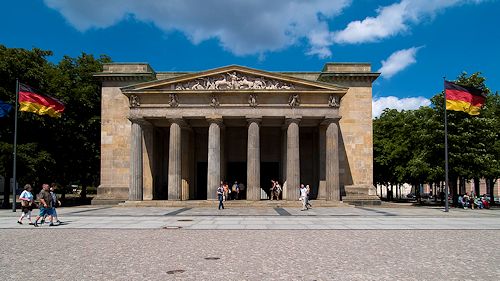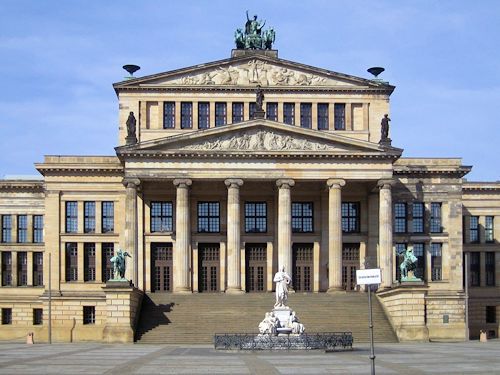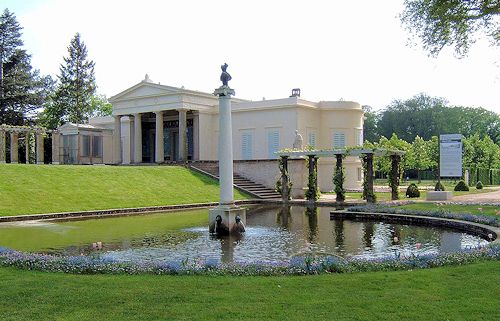2013.04.30 09:14
Donna Sink
So Schinkel isn't/wasn't a Nazi, but so much of his work was about glorifying the German culture and the hard work required to attain understanding and appreciation of it. So he was nationalist and elitist. But my god, the proportions, the sanity, the rigorous calmness of it all.....
2013.04.30 12:42
Eric Chavkin
I dont think Schinkel's architecture was glorifying German culture. It was Greek architecture. Ancient Greece was aquated with democracy. Schinkel, like many well-read Germans, was influenced by the writings Goethe, Hegel, Schelling etc.
2013.04.30 13:22
Erik Evens
A couple of beautiful Schinkel buildings within walking distance of my hotel in Berlin-
The Neue Wache:

The Konzerthaus in Gendarmenmarkt square:

And in Sansouci Park in Potsdam, we visited this beautiful, small palace, the Charlottenhof:

2013.04.30 13:22
Thayer-D
At what point does an imported style (for whatever reason) become a native style? In Schinkle's case, he employed Greek Classicism so masterfully that now his version is inectricably tied to Germany, the nation he sought to celebrate with his great buildings. One example of many where by the quality of the work overpowers any question of provenance.
| |
2013.04.30 16:56
Quondam
Schinkel was a gifted experimenting eclectic and a very talented assimilator. He study-toured Italy, Paris and England; he never visited Greece. His primary clients/employers were Prussian royalty and the Prussian government; there was no German nation yet. Schinkel did on occasion speculate as to what the most fitting style of architecture for Prussia might be, while at the same time many thought Cologne Cathedral to be the best symbol of 'German' architecture. The notion of Schinkel's architecture being a glorification of German culture came after the fact. Leo von Klenze, Schinkel's contemporary in Bavaria, did do a few projects where the program was to glorify German culture, however.
In many ways Schinkel also learned much from architectural publications of the time, particularly Piranesi, Durand and Stuart & Revett's record of ancient Greek architecture.
Incidentally, the first scheme for Charlottenhof was drawn by the Crown Prince for whom the villa was built.
2013.04.30 16:56
Donna Sink
Thank you, I had confused von Klenze's Walhalla as being by Schinkel.
2013.04.30 09:37
Quondam
I hear Wolfhilde von Schlittenfahrt is working on a book entitled
Architecture as a Glorious Whole.
No doubt she'll do it justice. I bet the last chapter is called "The Narrow Escape."
| |
2018.06.08 17:55
Quondam
About two weeks ago I arbitrarily decided to reread Marco Biraghi's Projects of Crisis: Manfredo Tafuri and Contemporary Architecture. It's a book I've owned since it's publication in English 2013.08.30, and read the book straight through from beginning to end at that time. Subsequently, I've reread the second chapter, "Kahn as Destroyer," several times, and presently I decided to start by reading "Epilogue: The Double Life of Contradiction." Six pages in there is a sentence that gave me great pause: "Insofar as the skyscraper is a "reproduction of the World" and a "glorious whole," a "self-contained universe" (Koolhaas's emphasis), it shares in a utopian tension." What? Koolhaas has already referred to architecture as a "glorious whole!?"
Since 2018.04.13, quondam.com has been publishing "architecture as a glorious whole." The title comes from a 2013.04.30 post at archinect/forum, and the notion of "glorious" stems from the several uses of the word "glorify" in prior posts within the same thread. Still, I had to wonder whether I was somehow subliminally aware of Koolhaas's use of the phrase "glorious whole," although it certainly was not through reading Projects of Crisis since its publication postdates the "architecture as a glorious whole" post at archinect.com. The phrase "glorious whole" occurs twice within Delirious New York: A Retroactive Manifesto for Manhattan, each instance within quotation marks because this "Glorious Whole, quite beyond the control of human imagination" is taken from The Cathedral of Commerce (1917), a book about the Woolworth Building. I've owned a used first edition of Delirious New York since 2005, but I've never read the book from beginning to end, therefore I may or may not have already read the phrase "glorious whole."
Originality in this case isn't necessary, but it is preferable, thus "architecture as a glorious whole" is now entitled "architecture as a fictitious [w]hole."
From a fortune cookie opened ten minutes ago: Understanding the nature of change, changes the nature.
|